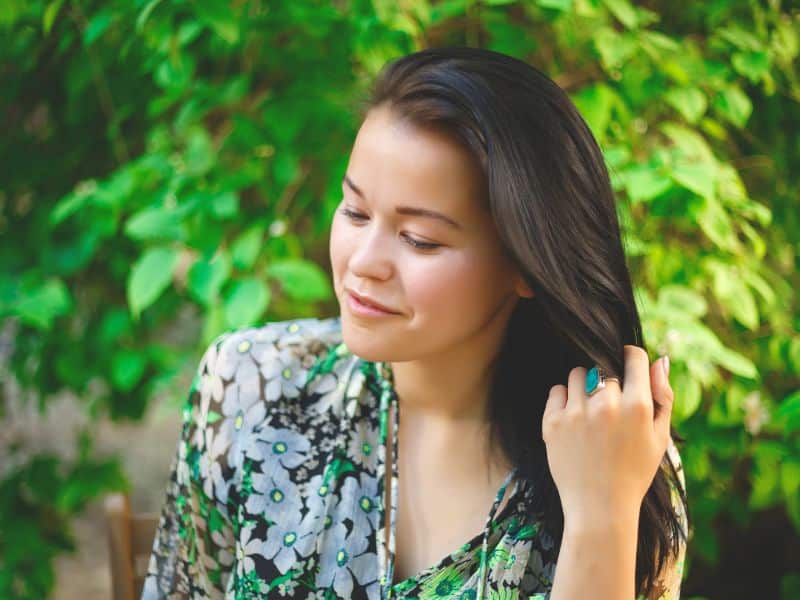Welcome to the vibrant and exciting world of sustainable hair coloring! Gone are the days when hair coloring was synonymous with harsh chemicals and environmental concerns.
Today, a beautiful transformation of your tresses doesn’t have to come at the expense of your health or the planet.
In this delightful journey towards eco-friendly beauty, we’re seeing a refreshing wave of change. More and more people are turning to natural and organic hair dyes, embracing products that are kind to their hair and the environment.
It’s not just a trend; it’s a movement towards mindful beauty practices that celebrate both personal and planetary health.
Whether you’re a seasoned hair coloring enthusiast or new to the game, this green revolution in hair color is all about making choices that feel good and look fantastic.
So, let’s get started on this colorful adventure and discover how you can be part of this positive change!
As an Amazon Associate, I earn from qualifying purchases
Table of Contents
- Why Traditional Dyes are Yesterday’s News
- Natural Dyes: Your Hair’s New Best Friends
- What Are Eco-Friendly Hair Dyes Made Of?
- Popular Natural and Organic Hair Dye Brands
- #1 Naturtint Permanent Hair Color
- #2 Schwarzkopf Simply Color
- #3 Revlon Total Color
- Choosing the Right Organic Hair Dye For You
- DIY Natural Hair Coloring Options
- How to Maintain Organic Hair Color
- Parting Words
- Our Research & Review Process
Why Traditional Dyes are Yesterday’s News
As we step into the era of sustainable hair care, it’s important to look back and understand why traditional hair dyes are falling out of favor.
The Hidden Truth of Hair Dye Ingredients
For years, many of us didn’t think twice about what was in our hair dye. But, as it turns out, some of those tiny print ingredients were not as harmless as we assumed.
However, deeper scrutiny reveals that some commonly used chemicals in these dyes are not as benign as previously thought.
The Problem with P-Phenylenediamine (PPD):
One of the most common culprits in conventional hair dyes is P-Phenylenediamine (PPD).
PPD is praised for its ability to provide lasting color. Yet, it’s infamous for causing skin irritation and allergic reactions, which can range from mild to severe.
The Ammonia Factor
Then there’s ammonia – another regular in traditional hair dye formulas.
It plays a key role in helping color penetrate the hair shaft. However, this effectiveness comes with a price. Ammonia is notorious for its strong, pungent smell – a telltale sign of its presence.
More than just an unpleasant odor, New York State Department of Health tells us that ammonia can cause respiratory issues and throat irritation, making the coloring process less than comfortable for many.
Environmental Concerns
Beyond personal health, these chemicals can negatively impact the environment.
When washed out, substances like ammonia can harm aquatic life and contribute to wider ecological issues.
Expert Insights
“As an alternative to the synthetic hair dyes, botanical colorants are advantageous as they are green in nature, less toxic and biodegradable.”
Recent Advancements in Natural Plant Colorants Used for Hair Dye Applications: A Review, Published on PubMed
A Growing Consciousness
This increasing awareness is leading people to seek out safer, more eco-friendly hair coloring options.
The beauty world is evolving, with a clear shift towards products that are kinder to both our health and the environment.
The shift away from traditional dyes signifies a broader change in beauty trends – one that values health, safety, and environmental sustainability. The future of hair coloring is undoubtedly in safer, greener alternatives.
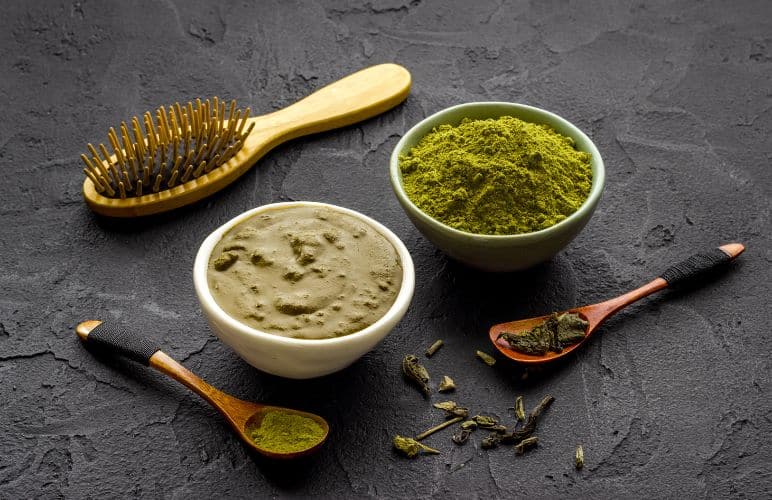
Natural Dyes: Your Hair’s New Best Friends
Welcome to a world where hair color meets the magic of nature. In the vibrant realm of natural dyes, things are a bit different – and, dare we say, exciting! These dyes, hailing from Mother Nature’s palette, are transforming the way we think about hair coloring.
The Gentle Touch of Nature
Natural hair dyes are a gentle embrace compared to the firm grip of traditional dyes.
Free from harsh chemicals like PPD and ammonia, these plant-based wonders are kinder to your scalp and hair.
Ingredients such as henna, indigo, and other botanical extracts have been coloring hair for centuries.
They color, but they also care, minimizing the risk of damage and allergic reactions.
Healthier Hair, Happier You
The absence of synthetic chemicals means these natural dyes are much more than just a coloring agent.
They maintain the integrity of your hair, nurturing and protecting it as they impart vibrant hues.
This means you can say goodbye to the worry of damaging your hair with every color session.
Expert Insights
“Clients often tell me how their hair feels stronger, looks shinier, and overall appears healthier since switching to natural dyes.”
Enza Piazza, Hair Stylists & Color Consultant
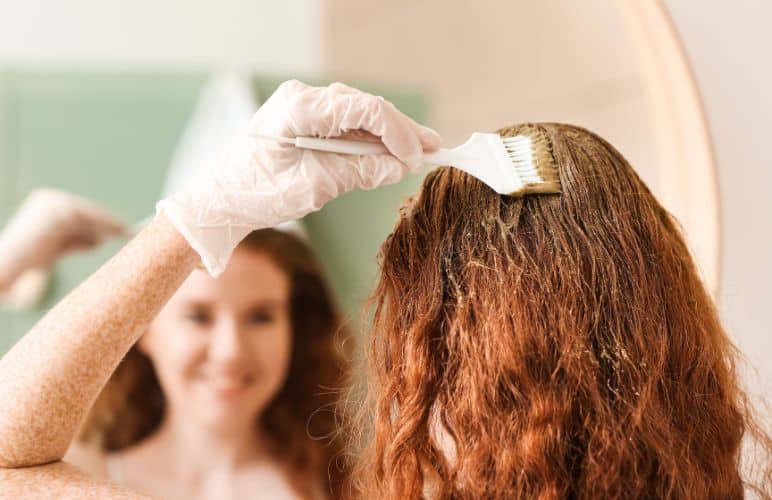
A Friend to the Environment
Natural dyes are not just about looking good; they’re about feeling good too. These plant-based dyes biodegrade gracefully, ensuring minimal impact on our precious waterways and ecosystems.
When you rinse away these colors, you’re not sending a cocktail of harsh chemicals down the drain.
Sustainability at Its Core
Sourcing matters, and many natural dyes come from sustainable practices – local insects, plants, vegetables and minerals.
Choosing these dyes means supporting an environmentally conscious approach to beauty. It’s not just a color change; it’s a positive contribution to the planet.
Switching to natural and organic hair dyes is more than a beauty choice; it’s a commitment to both personal and planetary well-being.
So why not give your hair and the environment the gift of natural color? Your vibrant locks will be a testament to the power of nature’s best.
What Are Eco-Friendly Hair Dyes Made Of?
Natural hair dyes differentiate themselves from conventional dyes through their unique, plant-based compositions. Here’s a quick look at what typically goes into these gentler hair color solutions:
- Henna: Derived from the leaves of the Lawsonia inermis plant, henna is a popular natural dye that imparts a reddish-brown tint to hair.
- Indigo: Often used in conjunction with henna, indigo, derived from the Indigofera tinctoria plant, offers deeper, darker hues, especially rich blues and blacks.
- Cassia Obovata: Sometimes referred to as “neutral henna,” it’s used to condition hair and provide a slight yellow tint, enhancing natural blonde tones.
- Herbs and Plants: Various herbs like chamomile, rhubarb root, and beetroot are also used, each contributing their unique shades and benefits to the hair.
- Natural Oils: Essential oils like tea tree or lavender are often added not for color, but for their scalp-soothing properties and pleasant fragrances.
These ingredients not only color the hair but also often provide nourishing and conditioning benefits, making natural hair dyes a holistic approach to hair coloring.
Popular Natural and Organic Hair Dye Brands
Navigating the world of natural and organic hair dyes can be a thrilling adventure, especially with so many fantastic brands leading the charge towards healthier hair coloring options.
Here’s a spotlight on some of the top brands that are making waves in the eco-friendly beauty world:
#1 Naturtint Permanent Hair Color
Features & Ingredients
- Naturtint stands out for its all-natural, chemical-free formulation.
- Formulation includes oleic acid from olives and meadow seed oil for hair nourishment.
- Offering over 28 mixable shades, from ash blonde to ebony black.
- Naturtint is perfect for those seeking a wide variety of color options without the harsh compounds like ammonia, parabens, and silicones.
- Nourishes and protect the hair, reducing frizz and repairing split ends.
Reviewers say:
“My sensitive scalp finally found its match! Naturtint gives me rich color without irritation.”
Alex S, Naturtint USA
“I’ve used Naturtint for my gray coverage, and it’s incredibly effective. Plus, my hair feels healthier!”
LouMorr, Makeup Alley
“I found this kit easy to use and it coloured my hair evenly, not leaving horrible patchy bits around the roots that I’ve found with kits in the past.”
Debbie, WhatsGoodToDo
Our experience
When we tried Naturtint, the first thing we noticed was how gentle it felt on the scalp. The application was smooth, and the color developed into a rich, natural shade. The lack of harsh chemicals was apparent, as there was no typical dye smell or scalp irritation. After several washes, the color remained vibrant, and our hair felt stronger and healthier.
Best for: Sensitive Scalps
Pros
- Chemical-free formulation.
- Wide range of natural colors.
- Nourishes and protects hair.
Cons
- May require multiple applications for vibrant results.
#2 Schwarzkopf Simply Color
Features & ingredients
- Schwarzkopf Simply Color is celebrated for its botanical-based formula.
- Available in six shades of brown, it’s a go-to for those looking for natural brunette tones.
- Free from synthetic chemicals, peroxides, and alcohol, this dye uses oat milk, soy protein, and argan oil, which are kind to your hair and scalp.
Reviewers say:
“I was super satisfied with the result of this hair color. The color payoff is great, covered my grays; we shall see how long it lasts. My hair felt smooth and soft afterwards.”
Christina T, Influenster
“I tried it for the first time. Great color and easy to apply. Would have been 5 stars but the box didn’t contain the gloves.”
Cathy P, Review on CVS.com
Our experience
Using Schwarzkopf Simply Color was a pleasant surprise. The formula was indeed gentle, and the color looked incredibly natural.
It was impressive how the botanical ingredients left the hair feeling soft and nourished, without any of the usual damage associated with hair coloring. Most of all, the color looked great on our cool brown hair.
Best for: Natural Brunettes
Pros
- Exclusively botanical ingredients.
- Nourishes and conditions hair.
- Free from harmful chemicals.
Cons
- Limited color range.
#3 Revlon Total Color
Features & ingredients
- Revlon Total Color offers a vegan line that’s free from ammonia, parabens, sulfates, and silicones.
- With 32 colors available, it caters to a vast range of preferences, from extra light blonde to black.
- Revlon’s natural hair dyes are not only gentle but also infused with nourishing hemp seed oil, offering long-lasting coverage and health benefits for your hair.
Reviewers say:
“Revlon TOTAL COLOR™ was a bloody delight to use if I’m honest. It felt really refreshing, and was lovely and soft on my scalp, definitely no itching or burning.”
Cate Gilpin, Mamamia.com
“This is the best hair color ever and I have been coloring my hair for 30 years….I have to color every three weeks as most colors turn orange and fade out…this holds its color like nothing I have ever tried before.”
Checotah44, MakeUpAlley
Our experience
Revlon Total Color impressed us with its variety and the quality of the color. The vegan formula not only provided excellent coverage but also left our hair feeling healthier and more vibrant. It was a relief to use a hair dye that didn’t compromise hair health for color.
Best for: Vegan Color Variety
Pros
- Huge variety of colors.
- Long-lasting coverage.
- Vegan and gentle formula.
Cons
- May require more product for thicker or longer hair.
#4 The Henna Guys Henna Cones Paste
Features & Ingredients
- Made from 100% natural henna.
- Ready-to-use cones for easy application.
- Ideal for spot hair coloring and detailed designs.
Reviewers say:
“As someone who loves experimenting with hair color, I found these henna cones to be super convenient and easy to use.”
Olivia P, The Henna Guys
“I used it for adding some fun accents to my hair, and the results were vibrant and long-lasting.”
Iryna H, Influenster
Our experience
When we tried The Henna Guys’ henna cones, we were initially impressed by the ease of application. The cones made it simple to apply the henna precisely where we wanted it, perfect for spot coloring or adding streaks of color.
The paste consistency was just right – not too thick or runny. We left it in our hair for about two hours before rinsing it out. The color developed into a rich, deep tone that genuinely complemented our natural hair color. It’s worth noting that the color payoff and longevity can vary depending on your hair type and the duration you leave the paste on.
Best for: Spot Coloring
Pros
- 100% natural henna, free from chemicals.
- Convenient, mess-free application with cones.
- Vibrant, long-lasting color.
Cons
- Time-consuming application process.
- Results may vary based on hair type and color.
Each of these brands brings something special to the table, from Naturtint’s extensive color range and natural ingredients to Schwarzkopf’s botanically rich formula and Revlon’s commitment to vegan, gentle products.
Whichever brand you choose, you’re making a positive step towards healthier hair and a happier planet.
Choosing the Right Organic Hair Dye For You
Selecting the perfect organic hair dye is about more than just picking a favorite color. It’s about finding the right harmony between shade, formulation, and how it interacts with your unique hair type. Here are key factors to consider:
1. Color Availability:
Range Matters: First, look at the range of colors available. While natural dyes may not offer as wide a spectrum as conventional dyes, many brands provide a variety of shades.
Specific Needs: Consider whether you need hair dye for gray coverage, highlights, or full hair color change. Some organic dyes excel in certain areas more than others.
2. Formulation:
Ingredients List: Check the ingredients for any potential allergens or irritants, especially if you have sensitive skin.
Added Benefits: Look for dyes with nourishing ingredients like natural oils or herbal extracts that can benefit your hair health.
3. Performance:
Longevity: Consider how long the color is likely to last. Organic dyes can range from semi-permanent to permanent.
Hair Type Compatibility: Some dyes work better on certain hair types or textures. Read reviews or consult with a stylist to see if a dye is a good match for your hair.
Top Tips for Selection
- Test Before Application: Conduct a patch test to ensure you don’t have an allergic reaction to the dye.
- Seek Advice: Don’t hesitate to consult a professional hairstylist, especially if you are new to organic hair dyes.
- Start Simple: If you’re new to organic hair dyes, you might start with a semi-permanent dye to see how you like the effect.
- Research and Reviews: Look up reviews and experiences from people with similar hair types and color preferences.
By considering these factors, you can make an informed decision that not only brings out the best in your hair but also aligns with your health and environmental values.
DIY Natural Hair Coloring Options
Embracing DIY natural hair coloring is not just a creative endeavor but also a fun way to experiment with your look using ingredients from your kitchen. Here are some easy-to-make, natural dye recipes:
#1. Lemon Juice for Natural Highlights
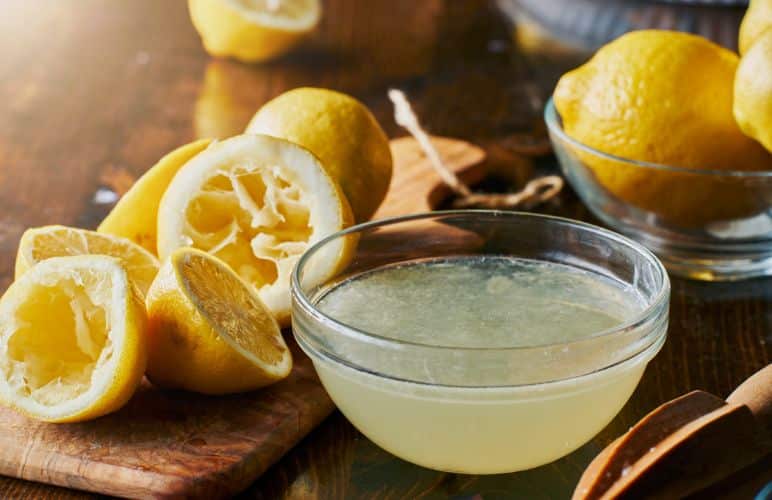
- Ingredients: Fresh lemon juice.
- Method: Mix lemon juice with a bit of water. Apply it to the sections of hair you wish to lighten. Sit in the sun for optimal lightening.
- Best for: Creating natural-looking highlights, especially in blonde or light brown hair.
#2. Chamomile Tea for Gentle Lightening
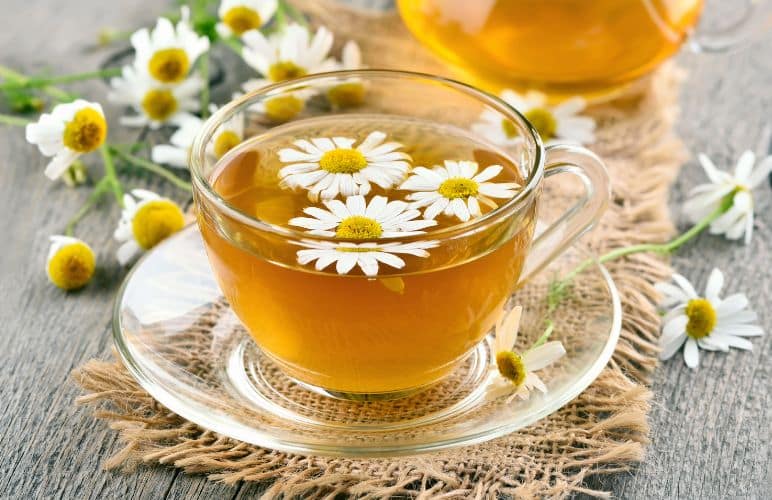
- Ingredients: Chamomile tea bags, water.
- Method: Brew a strong chamomile tea and let it cool. After shampooing, rinse your hair with the tea and let it sit for 15-20 minutes before rinsing with water.
- Best for: Adding subtle golden highlights to lighter hair.
#3. Beet and Carrot Juice for Red Tints
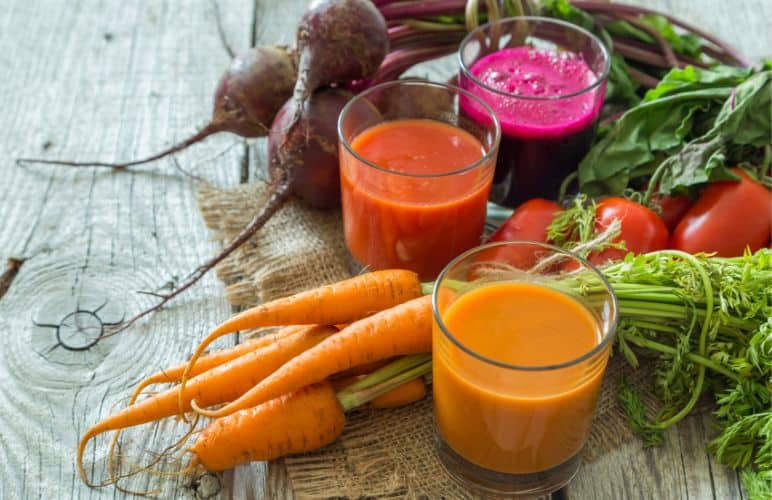
- Ingredients: Beet juice, carrot juice.
- Method: Mix beet and carrot juice in equal parts. Apply to hair, wrap with plastic, and leave it for an hour before washing out. Adjust the ratio to get different shades of red.
- Best for: Adding a reddish tint to darker hair or enhancing red hair.
#4. Coffee for Darkening Hair

- Ingredients: Strong black coffee.
- Method: Brew a strong cup of dark roast coffee, let it cool, then mix it with your conditioner. Apply it to your hair, letting it sit for about an hour before rinsing.
- Best for: Darkening hair or adding depth to brown hair.
#5. Henna for Rich Reds and Browns
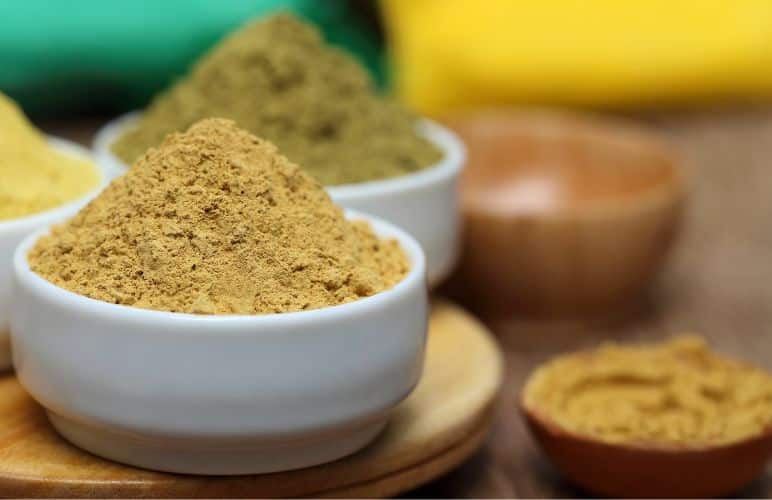
- Ingredients: Henna powder, water.
- Method: Mix henna powder with enough water to form a paste. Apply to hair, leave it for 1-4 hours depending on desired intensity, then rinse.
- Best for: Achieving vibrant reds or deepening brown hair.
Tips for DIY Hair Dyeing
- Patch Test: Always do a patch test to ensure you don’t have an allergic reaction.
- Preparation: Cover your workspace and wear old clothes as natural dyes can stain.
- Application: Use gloves to apply dyes to avoid staining your hands.
- Follow-up: After rinsing out the dye, a vinegar rinse can help set the color.
How to Maintain Organic Hair Color
Getting the most out of your organic hair color is all about the right care and maintenance. Here are some tips to help you keep that vibrant color and healthy hair for longer:
Wash Smartly
Limit Washing: Over-washing can fade organic hair colors faster. Try to reduce the frequency of your hair washes.
Use Gentle Shampoos: Opt for sulfate-free shampoos that are gentler on your hair and won’t strip the color quickly.
Condition Regularly
Deep Conditioning: Use a deep conditioner or hair mask once a week to keep your colored hair moisturized and healthy.
Leave-in Conditioners: Consider leave-in conditioners for added moisture and protection throughout the day.
Avoid Heat Styling
Reduce Heat: Excessive heat styling can damage and fade colored hair. Try to air-dry your hair and use heat-protectant sprays when necessary.
Lower Temperature: If using heat styling tools, opt for lower temperature settings.
Protect Your Hair
UV Protection: The sun can fade hair color, so use hair products with UV protection or wear hats when out in the sun.
Chlorine and Salt Water: Both can strip color from your hair. Wear a swimming cap or rinse your hair immediately after swimming.
Touch-Ups
Root Touch-Ups: Use organic color kits designed for root touch-ups to maintain an even color as your hair grows.
Refresh Your Color: Use color-enhancing shampoos or semi-permanent dyes to refresh your color between full dye sessions.
Healthy Diet and Hydration
Nutrition: A healthy diet rich in vitamins and minerals can improve hair health.
Stay Hydrated: Drinking plenty of water helps in maintaining overall hair health.
Trim Regularly
Regular Trims: Keeping your hair trimmed helps avoid split ends, making your color look fresher and your hair healthier.
Remember, organic hair colors are different from traditional chemical dyes, and they may require a bit of extra care. But with these tips, you can enjoy vibrant, healthy, and beautifully colored hair for longer.
Parting Words
In this journey through the world of sustainable hair care, we’ve uncovered the significant benefits of switching to natural and organic hair dyes.
From the health-friendly attributes of plant-based ingredients to the environmental advantages of reducing chemical runoff, the shift towards natural hair coloring is more than just a beauty trend – it’s a step towards a healthier, more sustainable lifestyle.
By choosing these sustainable options, you’re joining a growing movement that values personal health and ecological well-being. Hurrah!
Further References
Throughout this article, we’ve referenced various sources and studies that highlight the benefits and practical aspects of natural and organic hair dyes. These references are invaluable for anyone looking to explore this topic further and make informed decisions about their hair care choices.
Embrace the change, and be a part of the green revolution in hair care!
Found your perfect shade? We’d love to see it! Tag us on Instagram @colouredhaircare or Facebook and share your hair dye success stories. Looking for more hair care tips? Check out How to Look After Colored Hair: 11 Expert Secrets For Long-Lasting Color.

Our Research & Review Process
To ensure our recommendations are as comprehensive and reliable as possible, we’ve undertaken an extensive research effort.
We cite scientific evidence and journals, collect real user reviews and gather impartial perspectives from hair stylists, users, and experts in the field.
Additionally, we conduct hands-on testing by using products and applying hair dyes not only on our own locks but also on real human hair extensions and hair pieces of different hair type, textures and lengths.
This rigorous approach allows us to provide you with insights into which products genuinely live up to their promises.
As always – please consult with a professional hair colorist or stylist for advice on how to color your own hair at home. It’s different for everyone!
